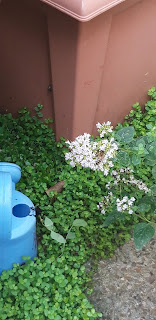I saw a peregrine falcon this
morning. This is not something you can say every day. Picture the scene (for those
of you lucky enough to know it); Alexandra Palace, a beautiful blue sky,
looking across one of the finest views in London. A bird flying towards me, I
see it’s a raptor, a bird of prey. Is it a kestrel? As it approaches and straightens
up, I see the curved wings, the long rectangular tail. It flies like a
rocket, barely fifty feet above my head, I recognize it. It’s a peregrine.
Seconds later it’s gone, disappearing over the roof of the palace. "Wow", to quote Steve Mcqueen in The Great Escape. Not bad
for 8.45 in the morning. It’s a moment us nature folk remember. No-one
else except me saw it. I wish someone else had. These brief encounters go somewhere
deep. It’s been a summer of brief encounters. A giant hoverfly visited for a minute of two, an emperor dragonfly too and I saw a bat last night in the
garden. Twice in two minutes, only about the third time that has happened this
entire summer, unlike previous ones when they were almost nightly visitors. I
love bats, but more of them in a second.
We often
and sadly hear or read about our destruction of nature. It’s not a new problem
and not one I’m going to talk about. Less often, we hear of success stories in
conservation, but the magnificent peregrine falcon is one. By the 1960’s the UK
population was decimated. Shot in high numbers during the war as a result of
their predilection for pigeons carrying messages regarding the war effort and
then damaged by pesticides – being top of the food chain, like orca whales, for
instance, residual pesticide build-up is devastating – as well as eggs being
taken by ‘collectors’, their future looked ominous. A ban on the DDT pesticide
and nest protection by the RSPB, for example, allowed the population to
recover. Another interesting development, is their moving into urban areas, including
London. High buildings act as a substitute for the cliff sides which are their
natural habitat and further to that, they are actually often commoner in urban
areas these days than rural. The plethora of town pigeons proving popular. A
glance at their UK distribution from my RSPB bird book from 1988, shows how rare
they were in the south-east. Nature finds a way to adapt. The lack of wading and
other birds in the countryside that they feed on, has led them to move to the
cities. City conservation seems to be the way forward, with gardens and parks
covering millions of acres but that shouldn’t detract from the problems rural
areas face as intensive farming turns them into deserts.
Bats. I’m
not sure enough people love them. Dracula and Bram Stoker probably didn’t help
their reputation and granted, they are odd creatures, especially when seen
close up. But to see a bat flitting through the sky, their silhouette
contrasting against the blue of dusk, in the silence, is a magical experience.
The air is their natural habitat. Using radar to identify their insect prey,
they are remarkable and if you see bats you know that insects are not far away.
They need a green corridor to navigate i.e. trees, so you’ll be less likely to
see them in a truly urban area. In Barnes, in SW London you can sit in the beer garden
of the Red Lion pub and bats fly above your head. Dragonflies too. Bat boxes in gardens help
them. Every year I say I’ll do it then I’m too late. Next year without fail.
The swifts
have gone from the north London sky. This is always a pity. Heading back to
Africa for the winter, I’ll miss their screeching and athleticism. They’re the
first sign of summer’s wane. I was lucky enough, however, to see some swallows
up close last weekend on a visit to Redmires, South Yorkshire, resting place of my late friend Dan. He was a birder, like me. As we stood where his ashes lie, three swallows appeared, gliding, just above our heads, almost
stationary in the strong winds blowing across the moors. Another of those moments. Swallows are not city dwellers
unlike me so that was a thrill. Not quite the athletes that swifts are but more
beautiful with their blue and red plumage and forked tails.
The summer
bloom is gradually fading from its peak in late July. There is a little less
colour, some plants, such as the scabious and lavender have gone but there is
still much to admire. The roses are still healthy, my tomatoes may have a late
surge due the heat which is finally returning this week and a solitary honeybee
continues to enjoy my Oregano flowers. And with the pink Hydrangea it really is
a case of quality not quantity. There is only flower, but it’s a beauty. A
garden like life, is dynamic, ever changing. Sometimes this is sad, like the swifts’
departure, but you ‘gotta roll with it’, Man. There’s plenty to enjoy before
summer ends. The heat is back this week after a month of rain. Keep your eyes
open, you may see a bat, or a peregrine but I’d settle for a bee on a flower.




